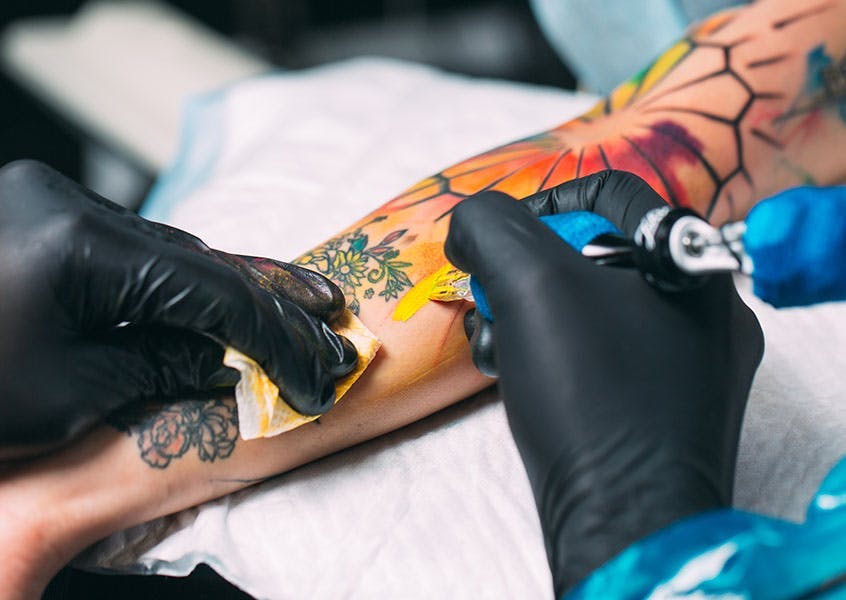Currently, tattooing is becoming increasingly popular, with various styles being used for fashion or for specific purposes, including covering up scars to make them look more beautiful. However, if we are not careful, there is a risk of infection. Today, we would like to share knowledge about this topic.
What is tattooing and how does it work?
Tattooing is the process of applying color and various patterns on the body. Tattoos can be temporary or permanent. Each culture has its own specific meanings and purposes for tattooing. However, the important thing is that improper tattooing can cause health problems such as infection, contagious diseases, and the use of non-standard needles. The tattooing process involves using small needles to penetrate the dermis layer. Each time the needle punctures, ink seeps into the layers beneath the skin, resulting in a pattern along the tattoo.
Dangers of tattooing
Although the results may look good, tattooing also poses risks to one's health. Some of the dangers that can arise from tattooing include:
· Allergic reactions to tattoo ink, especially red, green, yellow, and blue inks, each of which is made from different substances. For example, red ink is made from insect wings, blue ink from cobalt chloride, black ink from charcoal, and yellow ink from cadmium. People who are allergic to these inks may experience skin irritation and rashes around the tattooed area because these colors are not made from natural ingredients.
· Bacterial infection: If the tattoo is done using equipment and needles that are not properly sterilized or in a non-standard tattoo parlor, it can lead to skin infections. This can occur due to Staphylococcus bacterial infections, which can cause pus-filled bumps on the skin.
· Viral infection: If the tattoo is done using unsterilized needles, there is a risk of viral infections transmitted through the bloodstream. This can lead to dangerous bloodborne infections such as HIV, hepatitis B, and hepatitis C.
· Keloid formation: Tattooing can cause keloid formation, which is raised scars that may enlarge and cause pain. It can also result in itching or irritation. Keloids occur due to the healing process of human skin.
Self-care after getting a tattoo
After getting a tattoo, it is important to take steps to prevent infections and various health problems. Here are some self-care tips:
1. Make sure the tattoo artist applies petroleum jelly to the tattooed area and covers it with plastic wrap or a bandage.
2. Remove the plastic wrap after 24 hours and wash the tattoo with an antibacterial soap, gently patting it dry.
3. Apply antibacterial ointment to the tattooed area twice a day without covering it with plastic wrap.
4. Clean the tattoo with soap and clean water for 2-4 weeks continuously to maintain moisture.
5. Avoid scratching or picking at the tattooed area.
6. Avoid sun exposure, hot baths, and swimming for 2 weeks, as they can cause the tattoo ink to fade and may result in irritation.
7. Do not peel, scratch, or remove scabs from the tattooed area. If you notice any redness, seek medical attention
Temporary tattoo is another option for beauty enhancement
Temporary tattoos provide a new alternative for people who want to have tattoos but don't want the pain, damage to the skin, or a design that can fade away over time. There are five methods of temporary tattooing:
• Airbrush Tattoos involve spraying paint onto a silicone sheet to create the desired design.
• Paint on Tattoos use ink and a painting technique to create unique designs that can last up to one week and can be removed with oil.
• Henna Tattoos are created using natural henna or plant-based dyes and are popular in India. The designs can last up to two weeks.
• Glitter Tattoos are suitable for those who want a sparkling tattoo. A special adhesive is applied to the skin and the glitter design is drawn on top. These tattoos last for one week and can be challenging to remove, requiring a one-week wait for them to fade.
• Sticker Tattoos or Transfer Tattoos are well-known, where a design is pressed onto the skin and then soaked in water for three minutes before peeling off. They typically last for a minimum of three days before being removed, but now there are various brands that have developed stickers with a lifespan exceeding three days.
While beauty is important, safety is equally crucial. Therefore, beauty accompanied by good health and safety is always preferable. For customers of Krungthai-AXA Life Insurance who are interested in health care, they can find more health-related articles at https://www.krungthai-axa.co.th/th/health-advisories.
Reference
· Ang Thong Hospital
· Pobpad
· Ramathibodi Hospital
· Wikipedia


